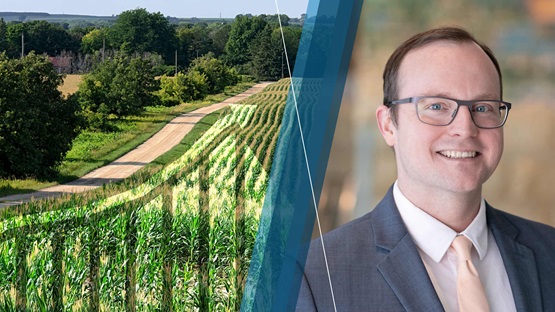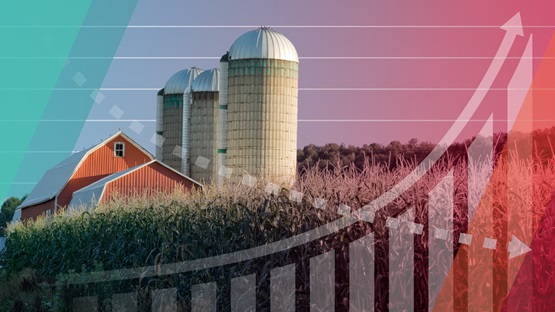After several strong years, growth stalled earlier in 2023, according to results from the Federal Reserve Bank of Minneapolis’ second-quarter agricultural credit conditions survey. Farm incomes decreased slightly on balance from April through June relative to a year earlier, according to the survey, which was conducted during July. Spending on capital equipment also dropped, while farm household purchases increased.
However, falling incomes did not boost loan demand and the rate of loan repayment remained strong, while renewals and extensions overwhelmingly held steady. Farmland values rose further, while cash rents also increased. The outlook for the third-quarter calls for further income declines, though overall financial conditions are expected to be relatively stable.
Farm income, household spending, and capital investment
“Commodity prices experienced a significant drop in value when compared to previous years,” said a North Dakota banker, resulting in “decreasing overall liquidity and working capital.” Many of their peers agreed, as 39 percent of lenders reported that borrower liquidity had decreased in the past three months from the same period a year earlier.
Farm incomes and spending decreased on the strength of crop and livestock prices. More than a third of Ninth District lenders surveyed reported that farm incomes decreased in the second quarter of 2023 from the same period in 2022, slightly higher than the share who reported increased incomes. A larger share reported that capital spending decreased. In contrast, farm household spending increased, according to nearly half of survey respondents.
Demand for loans, required collateral, and interest rates
Despite weaker incomes, demand for credit fell in the second quarter, according to lenders. More than a third of respondents indicated that loan demand decreased relative to a year earlier, compared with a quarter who reported greater demand. Collateral requirements were unchanged, according to a strong majority of lenders surveyed (88 percent), though the remainder reported that they increased. Average fixed and variable rates on operating, machinery, and real estate loans all increased further in the second quarter after a sizeable increase in the previous quarter.
Loan repayments and renewals
“Renewal season was again fairly easy this year with livestock and grain prices at their current levels,” commented a South Dakota lender. Loan renewals largely held steady or decreased across the district, while the rate of repayment on agricultural loans increased, reflecting overall stability in farm finances. Nearly 90 percent of lenders stated that the number of renewals was unchanged, with only 4 percent reporting that renewals increased. A fifth of respondents reported that loan repayments were up from a year earlier, while only 6 percent said that repayment rates decreased. Only 2 percent of banks reported having refused a loan due to a shortage of funds.
Cash rents and land values
Continuing a three-year trend, land values and cash rents grew further in the second quarter. Ninth District nonirrigated cropland values increased by 9 percent on average from the second quarter of 2022. Irrigated cropland values rose by just under 8 percent from a year earlier, while ranchland and pastureland values increased by 6 percent. The district average cash rent for nonirrigated land jumped by 4 percent from a year ago. Ranchland rents also increased by more than 4 percent, while rents for irrigated land increased more than 9 percent. Changes in land values and rents were somewhat mixed across district states, with higher rates of increase in North Dakota and South Dakota and smaller increases in Montana and Wisconsin.
Outlook
Expectations for the remainder of the growing season are heavily weather dependent. “We are a little dry at this time, a good rain would be welcome,” commented a North Dakota banker.
The outlook for the next few months calls for further downward momentum in incomes. Across the district, 58 percent of lenders expect that farm income will decline in the third quarter of 2023, compared with 19 percent forecasting increases. The outlook for capital spending is similarly negative, while expectations for household spending are slightly positive overall. Lenders predict that loan demand will grow on balance in the upcoming quarter, with 37 percent of lenders expecting increases and a quarter predicting decreased demand. The outlook for loan repayment is stable overall, as 63 percent of respondents expect no change in repayment rates. Almost all respondents are not planning to change collateral requirements for borrowers.
| MN | MT | ND | SD | WI | Ninth District | |
|---|---|---|---|---|---|---|
| Percent of respondents who reported decreased levels for the past three months compared with the same period last year: | ||||||
| Rate of loan repayments | 10 | – | 10 | – | – | 6 |
| Net farm income | 38 | – | 30 | 29 | 67 | 35 |
| Farm household spending | 5 | – | 10 | 12 | 33 | 10 |
| Farm capital spending | 43 | – | 30 | 41 | 33 | 38 |
| Loan demand | 33 | – | 30 | 41 | 33 | 35 |
| Percent of respondents who reported increased levels for the past three months compared with the same period last year: | ||||||
| Loan renewals or extensions | – | – | 10 | – | 33 | 4 |
| Referrals to other lenders | – | – | – | – | – | – |
| Amount of collateral required | 5 | – | – | 18 | 33 | 12 |
| Loan demand | 33 | – | 40 | 12 | – | 25 |
| MN | MT | ND | SD | WI | Ninth District | |
|---|---|---|---|---|---|---|
| Percent of respondents who expect decreased levels for the next three months: | ||||||
| Rate of loan repayments | 10 | – | 10 | 29 | 33 | 17 |
| Net farm income | 67 | – | 50 | 53 | 67 | 58 |
| Farm household spending | 14 | – | 40 | 6 | 33 | 17 |
| Farm capital spending | 52 | – | 40 | 41 | 33 | 44 |
| Loan demand | 33 | – | 20 | 35 | 33 | 25 |
| Percent of respondents who expect increased levels for the next three months: | ||||||
| Loan renewals or extensions | 10 | – | 10 | – | 67 | 12 |
| Referrals to other lenders | 5 | – | – | – | – | 2 |
| Amount of collateral required | 5 | – | – | 18 | 33 | 10 |
| Loan demand | – | 100 | 50 | 29 | 33 | 37 |
| Operating | Machinery | Real estate | |||||
|---|---|---|---|---|---|---|---|
| Fixed | Var. | Fixed | Var. | Fixed | Var. | ||
| Q3-21 | October | 4.6 | 4.5 | 4.4 | 4.3 | 4.2 | 4.1 |
| Q4-21 | January | 4.7 | 4.4 | 4.5 | 4.3 | 4.3 | 4.1 |
| Q1-22 | April | 4.7 | 4.6 | 4.7 | 4.5 | 4.5 | 4.3 |
| Q2-22 | July | 5.5 | 5.4 | 5.5 | 5.3 | 5.4 | 5.1 |
| Q3-22 | October | 6.5 | 6.3 | 6.2 | 6.1 | 5.9 | 5.8 |
| Q4-22 | January | 7.7 | 7.6 | 7.3 | 7.3 | 7.0 | 7.0 |
| Q1-23 | April | 8.1 | 8.0 | 7.6 | 7.6 | 7.3 | 7.4 |
| Q2-23 | July | 8.5 | 8.5 | 7.9 | 8.0 | 7.5 | 7.5 |
Joe Mahon is a Minneapolis Fed regional outreach director. Joe’s primary responsibilities involve tracking several sectors of the Ninth District economy, including agriculture, manufacturing, energy, and mining.





